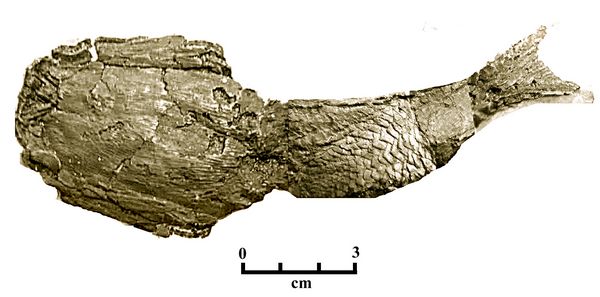Athena Review Image Archive ™
Arandaspis prionotolepis

Arandaspis prionotolepis (Nat.Hist.Mus.London)
Arandaspis prionotolepis, a jawless fish, is the oldest known vertebrate. Dating from the Ordovician period at 480-470 mya, it was discovered in the Stairway Sandstone Formation at Alice Springs, Australia. It is named Arandaspis for a local Aboriginal tribe, the Aranda. The species name prionoto- stands for "primary"; and -lepis for "scale". After the initial discovery in 1959 in Alice Springs by geologist David Taylor, it was later reanalyzed by Alex Ritchie of the South Australian Museum. The Alice Springs site has yielded two partly complete specimens and many bony plates and scales.
Arandaspis is one of a small group of marine fish known only from Ordovician sites in Australia and Bolivia. It belongs to the phylum Chordata, the class Pteraspida, and the subclass Arandaspida. Four distinct kinds of agnathans (jawless fish) have been found near Alice Springs, indicating that vertebrates existed and diversified long before the Middle Ordovician period.
The body length of Arandaspis is 15 cm (6 in). While its exterior had a bony shield, internally its backbone was made of cartilege. Its streamlined body was covered in rows of armored scutes or scales. The front of the body and head were protected by hard plates with openings for the eyes, nostrils and gills. While it lacked jaws, Arandaspis might have had some moveable plates in its mouth for ingesting food particles. The low position of its mouth suggests it foraged the ocean floor. It had no fins; its only method of propulsion was its flat tail.
The skull consisted of a 2-part bony shield, comprised of 2 large plates, which completely covered the head and gill region. The ventral (front or bottom) plate was deep and curved, the dorsal (back or upper) plate more triangular-shaped. Between these two plates there was a row of small, rhombus-shaped plates. It had a pair of eyes on the sides of the head, near the front, and in front of the small plates between the two halves of the head shield. There are 2 holes in the dorsal plate between the eyes. They appear to have been the openings of the pineal eye, a primitive sensing device.
References:
Ritchie & Gilbert-Tomlinson, 1977; Young 1997
Copyright © 1996-2020 Rust Family Foundation (All Rights Reserved).